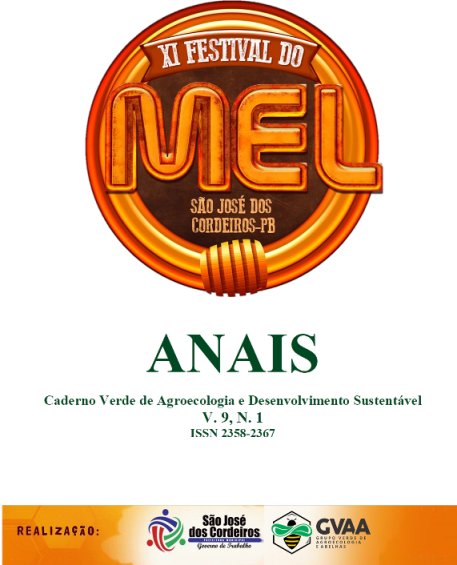PHYSICOCHEMICAL OF CREAMY SWEET PASSION FRUIT WITH HONEY
Keywords:
Apis mellifera, Regional Fruit, Fructose, Dessert, QualityAbstract
Creamy or paste candy is a product made from the fruit and sugar pulp under heating. Passion fruit is a regional fruit rich in varieties and widely used in the development of sweets in general. Honey contains in the composition higher concentration of fructose/glucose sugars and in lower concentration sucrose/maltose. Thus, the aim of this study was to analyze the physicochemical composition of creamy candies in different formulations with addition of honey Apis mellifera replacing sucrose/sugar. Four formulations were elaborated: A0 (100% sucrose); A25 (75% sucrose, 25% honey); A50 (50% sucrose, 50% honey); and A100 (100% mobile). The analyzes were performed at the Physical Chemistry Laboratory of the Federal Institute of Paraíba, Sousa campus. Samples were sorted in duplicates and the parameters analyzed were soluble solids content (ºBrix), pH, titratable acidity and reducing and total sugars. Results for the samples ranged from soluble solids (56.1 and 65.1 ºBrix); (3.16 and 3.19) pH; titratable acidity in organic acid (4.79 and 5.12); reducing sugars (13.33 and 30.43); total sugars (29.76 and 31.96). The substitution of honey reduced soluble solids content and pH, oscillation in titratable acidity (citric acid) and sample A100 obtained higher concentration of reducing fructose/glucose sugars, while the other samples showed levels of total sugars to similar values. In the light of the analyzes performed, further scientific research is needed involving the elaboration of creamy candies or in general with the addition or substitution of sucrose/sugar with honey, as its influence on the nutritional quality of the food is remarkable, and may attribute health benefits and meets a direct relationship with the consumption that looks for functional food.Downloads
Additional Files
Published
How to Cite
Issue
Section
License
Termo de cessão de direitos autorias
Esta é uma revista de acesso livre, em que, utiliza o termo de cessão seguindo a lei nº 9.610/1998, que altera, atualiza e consolida a legislação sobre direitos autorais no Brasil.
O(s) autor(es) doravante designado(s) CEDENTE, por meio desta, publica a OBRA no Caderno Verde de Agroecologia e Desenvolvimento Sustentável, representada pelo Grupo Verde de Agroecologia e Abelhas (GVAA), estabelecida na Rua Vicente Alves da Silva, 101, Bairro Petrópolis, Cidade de Pombal, Paraíba, Brasil. Caixa Postal 54 CEP 58840-000 doravante designada CESSIONÁRIA, nas condições descritas a seguir:
O CEDENTE declara que é (são) autor(es) e titular(es) da propriedade dos direitos autorais da OBRA submetida.
O CEDENTE declara que a OBRA não infringe direitos autorais e/ou outros direitos de propriedade de terceiros, que a divulgação de imagens (caso as mesmas existam) foi autorizada e que assume integral responsabilidade moral e/ou patrimonial, pelo seu conteúdo, perante terceiros.
O CEDENTE mantêm os direitos autorais e concedem à revista o direito de divulgação da OBRA, com o trabalho simultaneamente licenciado sob a Licença Creative Commons do tipo atribuição CC-BY.
O CEDENTE têm autorização para distribuição não-exclusiva da versão do trabalho publicada nesta revista.
O CEDENTE têm permissão e são estimulados a publicar e distribuir seu trabalho online (ex.: em repositórios institucionais ou na sua página pessoal) a qualquer ponto antes ou durante o processo editorial, já que isso pode gerar alterações produtivas, bem como aumentar o impacto e a citação do trabalho publicado.








